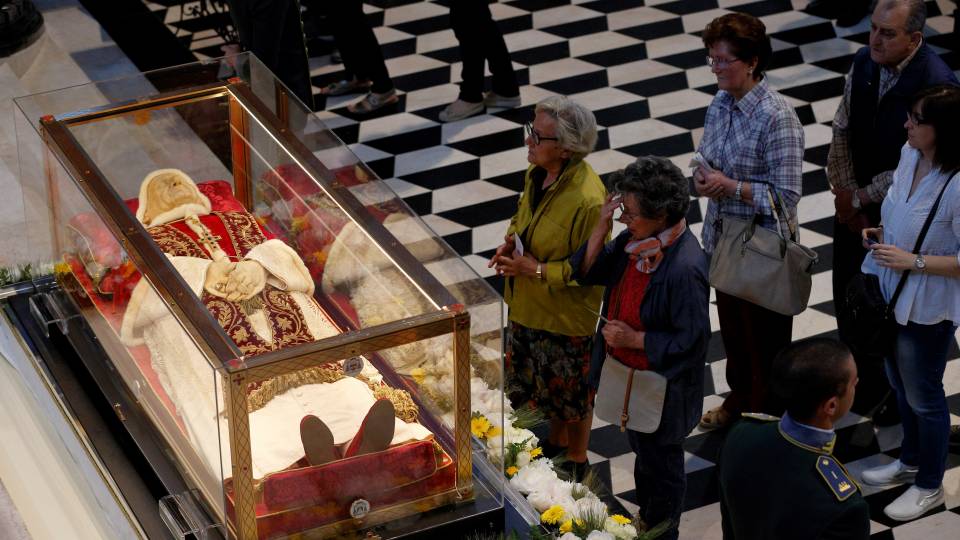

Papal Saints
Christopher M. Bellitto
Friday, October 11, 2019

People venerate the body of St. John XXIII in the cathedral in Bergamo, Italy, on May 25, 2018, during a pilgrimage of the late pope's remains to his home region (CNS photo/Paul Haring)
Something is clearly changing when it comes to papal saints in the last few decades.
Of the more than 260 successors of St. Peter, only 84 popes have been named saints—a bit less than a third. Almost all of the first 50 successors of Peter are venerated as saints. An additional 30 popes from about the years 500 to 1100 joined the list. But then the Church determined that just three of the 66 popes stretching from 1294 to 1914 were deemed worthy of canonization.
Compare those numbers with the fact that three of the four popes from 1958 to 2005 have now been made saints: John XXIII, Paul VI, and John Paul II. The fourth pope of that period, the smiling John Paul I of 33 days in 1978, is on his own path, having been declared venerable in 2017. These three popes taken together might even be seen as a canonization of sorts for Vatican II, given their key roles in starting, continuing, and implementing the council that Pope Francis is taking into the church’s third millennium.
What is going on? Are we in a golden age of the papacy?
The upsurge in papal saints is occurring in the context of an explosion of saint-making under John Paul II, sometimes known as the pope of saints. While the Church designated about 300 saints from 1234 to 1978, John Paul II named 482 during his long papacy of 1978 to 2005. He streamlined the saint-making process in a 1983 revision. Most notably, he changed the approach of the fundamental question about a person’s sanctity. In place of the darkly-named “devil’s advocate,” who reviewed the record and essentially said, “Prove that this person is a saint,” John Paul II instituted a “promoter for the faith,” who takes the stance, “Prove that this person isn’t a saint.”
Pope Francis has continued to make saints at a rapid pace, including the group canonization of 813 martyrs from southern Italy, which brings his total to almost 900 to date. His particular focus has been on Catholics who have died for the faith, which is a recognition that martyrdom isn’t only part of Church history but also current events. Francis also added a fourth category to the traditional three types of saints.
The first category is a life of heroic Christian virtue, which is the most common category by far, with Mother Teresa as a prime example in our own times. Second is martyrdom, typified by the earliest saints or Archbishop Oscar Romero in 1980, who was canonized with Paul VI. The third is equivalent canonization, which essentially means the paperwork is finally catching up with reality: everyone recognizes an uncanonized saint. This happened with the twelfth-century Hildegard of Bingen in 2012. Pope Francis added the fourth category of oblatio vitae, which is the free giving of your life for another person’s life. A retroactive example of this new category is Fr. Maximilian Kolbe, who took the place of a condemned fellow prisoner at Auschwitz in 1941 and died so that man, who had a family, could live. In canonizing him in 1982, John Paul II had called Kolbe “a martyr for charity.”
So the increase in papal saints is in line with an increase in saint-making generally. Both surges are not without their critics. John Paul II heard rumbling that he was de-valuing sainthood by making so many saints and dropping the role of devil’s advocate. An official during his papacy counter-argued that the pope was in fact re-valuing sanctity by demonstrating that everyone could live a life of service and virtue worthy of canonization. Francis thinks the process takes too long and costs too much, which is why organizations like religious orders are better equipped than, say, a local town to champion the cause of one of their own.
Finally: should any pope be canonized? Papacies are complicated affairs: there are theological and spiritual elements along with questions of authority, leadership, management, politics, economics, and social issues. Surely not everything a pope does is saintly — although we must recall that no canonization means the new saint was without fault or sin. So, too, each papacy has success and failure.
In terms of the widespread understanding of a papal saint, however, surely questions will be raised whether the Church is rendering a verdict on an entire papacy. The Church position on canonization is that she makes a person and not a papacy a saint: we canonize Angelo Roncalli and not Pope John XXIII. But in practice, this is not entirely true: he is known as St. John XXIII, not St. Angelo. How do you easily and clearly separate the person from this unique institution? When Angelo Roncalli acted, could we possibly say that here Angelo was at work but there Pope John was?
Perhaps the most complex example of this paradox is Pius XII. He made great strides in liturgical reforms and opened up scripture study in consequential ways, but his lasting legacy continues to be what he did and did not do to fight the Holocaust and protect Jews. He is hero to some and villain to others. Making a saint of Pius XII would add an extra veneer to his Church renewal agenda, to be sure, but would it also be seen as a rebuff (at the very least) to those inside and outside the Church seeking a full account and reckoning of his actions during World War II?
Another question: what happens if one pope does not quickly open a cause for sainthood of his immediate or recent predecessor? The way things are going now, it seems to be as automatic to put the prior pope up for sainthood as it was uncommon for hundreds of years. The standard practice is now totally reversed. There is now the expectation that the new pope will recommend his predecessor for the canonization process — but what if he doesn’t?
One response would be a moratorium on opening the cause for a papal saint entirely: no more papal saints. Another response would be to institute a longer waiting period than the current five years for all candidates. If there is not be a total ban of papal saints — a position that would be extreme when faced with obvious holiness — perhaps a longer embargo of at least 50 years would be in order. It is a discussion that the Church should have.
Christopher M. Bellitto, Ph.D., is Professor of History at Kean University in Union, New Jersey. His books include 101 Questions & Answers on Popes and the Papacy and, his latest, Ageless Wisdom: Lifetime Lessons from the Bible (both from Paulist Press). He has also been a guest on Salt + Light Media's Subject Matters, discussing his most recent book with Sebastian Gomes. You can watch the full episode by clicking here or on the player below.
Christopher M. Bellitto, Ph.D., is Professor of History at Kean University in Union, New Jersey. His books include 101 Questions & Answers on Popes and the Papacy and, his latest, Ageless Wisdom: Lifetime Lessons from the Bible (both from Paulist Press). He has also been a guest on Salt + Light Media's Subject Matters, discussing his most recent book with Sebastian Gomes. You can watch the full episode by clicking here or on the player below.
Related Articles:
<<













